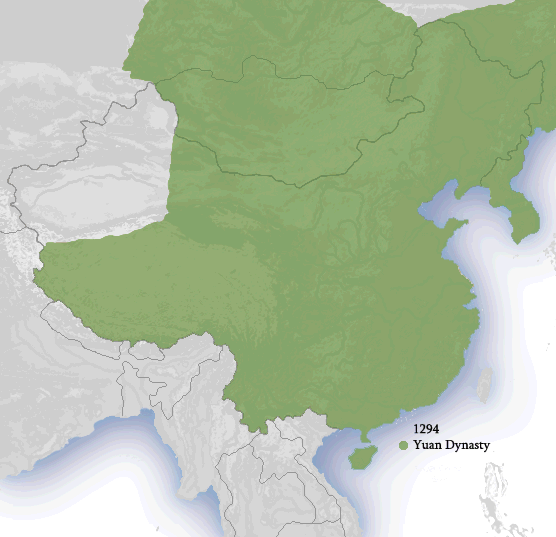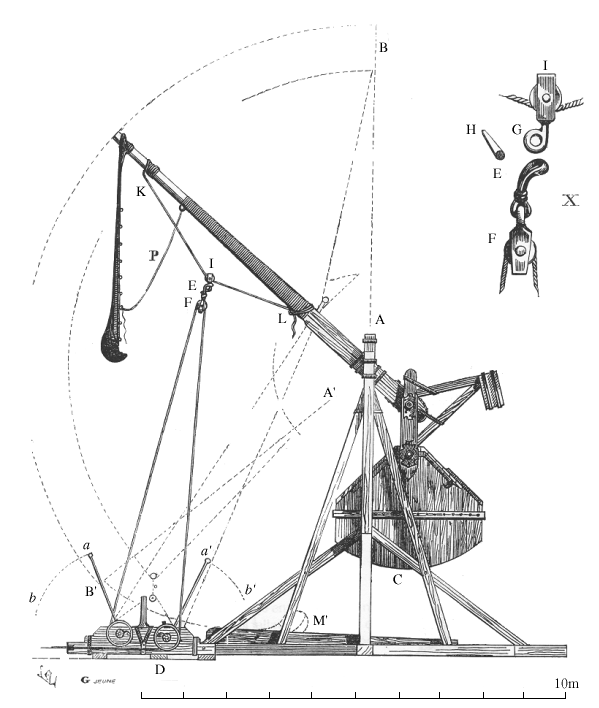9.7: Kublai Khan
( \newcommand{\kernel}{\mathrm{null}\,}\)
- Identify Kublai Khan’s most significant achievements
Key Points
- Möngke’s death led to civil war (or Toluid Civil War) between his two younger brothers; ultimately, Kublai Khan emerged victorious and renamed the empire as the Yuan Dynasty in 1271.
- Kublai also renamed himself Emperor of China in order to win over millions of Chinese subjects.
- Ultimately, under Kublai Khan, the Mongols were the first non-Chinese people to conquer all of China. However, their conquests of Japan and Java failed.
- At the time of Kublai’s death, the Mongol Empire fractured into four separate empires; this made it easy for the Han Chinese to overthrow them in 1368 and establish the Ming Dynasty.
Möngke’s death in 1259 led to civil war (often referred to as the Toluid Civil War) between his two younger brothers, Kublai Khan and Ariq Böke. Kublai Khan emerged victorious and established the Yuan Dynasty in China in 1271, perhaps the Mongols’ greatest triumph, though it would eventually be overthrown in 1368 by the native Han Chinese, who would launch their own Ming Dynasty.

Establishment of the Yuan Dynasty
After Kublai took over control of the Chinese territories with the blessings of Möngke Khan around 1251, he sought to establish a firmer hold on these vast regions. Rivaling dynasties loomed throughout the Chinese territories making for a contentious political background to Kublai’s rule. His greatest obstacle was the powerful Song dynasty in the south. He stabilized the northern regions by placing a hostage puppet leader in Korea named Wonjong in 1259. After the death of Möngke in that same year, and the following civil war, Kublai was named the Great Khan and successor of Möngke. This new powerful position allowed Kublai to oversee uprisings and wars between the western khanates and assist rulers (often family members) to oversee these regions. However, his tenuous hold in the east occupied most of his resources.
In 1271, as he continued to consolidate his power over the vast and varying Chinese subjects and outlying regions, Kublai Khan renamed his khanate the Yuan Dynasty. His newly named dynasty appeared to be successful after the fall of the major southern center Xiangyang in 1273 to Mongol forces after five years of struggle. The final piece of the puzzle for Kublai was the conquest of the Song Dynasty in southern China. He finally garnered this sought-after southern region in 1276 and the last Song emperor died in 1279 after years of costly battles. With this success, the Mongols became the first non-Chinese people to conquer all of the Chinese territories. Kublai moved his headquarters to Dadu, what later became the modern city of Beijing. His establishment of a capital there was a controversial move to many Mongols who accused him of being too closely tied to Chinese culture. However, the Yuan Dynasty often functioned as an independent khanate from the rest of the western Mongol-dominated regions.

Extended Invasions
Kublai Khan’s costly invasions of many territories in the east did not go smoothly and some went on for many years, draining the Mongol treasury and utilizing precious resources. Although the invasions of Burma in 1277, 1283, and 1287 forced the population to eventually capitulate, they were never more than a vassal state. Similarly, the Yuan forces invaded Sakhalin Island off the coast of modern-day Russia multiple times between 1264 and 1308, and the various tribal groups also eventually became a vassals after long years of turmoil. Southern Asian regions often agreed to Yuan rule and taxation only in the face of more bloodshed and terror. Conversely, Mongol invasions of Japan (1274 and 1280) and Java (1293) under Kublai Khan ultimately failed and illustrated the costly effects of constant invasive military tactics.
Yuan Dynasty Administration
Kublai Khan made significant reforms to existing institutions under the Yuan Dynasty. He divided the Dynasty’s territory into a central region and peripheral regions that were under the control of various officials. He created an academy, offices, trade ports and canals, and sponsored arts and science. Mongol records also list 20,166 public schools created during his reign. He also, along with engineers, invented the Muslim trebuchet (hui-hui pao), a counterweight-based weapon that was highly successful in battle.
He also continued to welcome trade and travel throughout his empire. Marco Polo, Marco Polo’s father (an Italian merchant), and his father’s trade partner traveled to China during this time. They met Kublai Khan and lived amongst his court to establish trade relations. Polo generally praised the wealth and extravagance of Khan and the Mongol Empire. Some historians also speculate that trade was so accessible between the empire and Europe, that it may have contributed to the flow of disease, especially the black plague in the mid-1300s.

By the time of Kublai’s death in 1294, the Mongol Empire had fractured into four separate empires, which were based on administrative zones Genghis had created. The four empires were known as khanates, each pursuing its own separate interests and objectives: the Golden Horde Khanate in the northwest, the Chagatai Khanate in the west, the Ilkhanate in the southwest, and the Yuan Dynasty, based in modern-day Beijing. In 1304, the three western khanates briefly accepted the rule of the Yuan Dynasty in name, but when the Dynasty was overthrown by the Han Chinese Ming Dynasty in 1368, and with increasing local unrest in the Golden Horde, the Mongol Empire finally dissolved.
Sources
- Boundless World History. Authored by: Boundless. Located at: https://www.boundless.com/world-history/textbooks/boundless-world-history-textbook/. License: CC BY-SA: Attribution-ShareAlike


